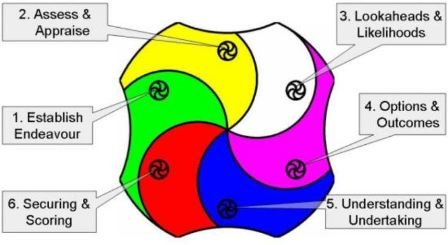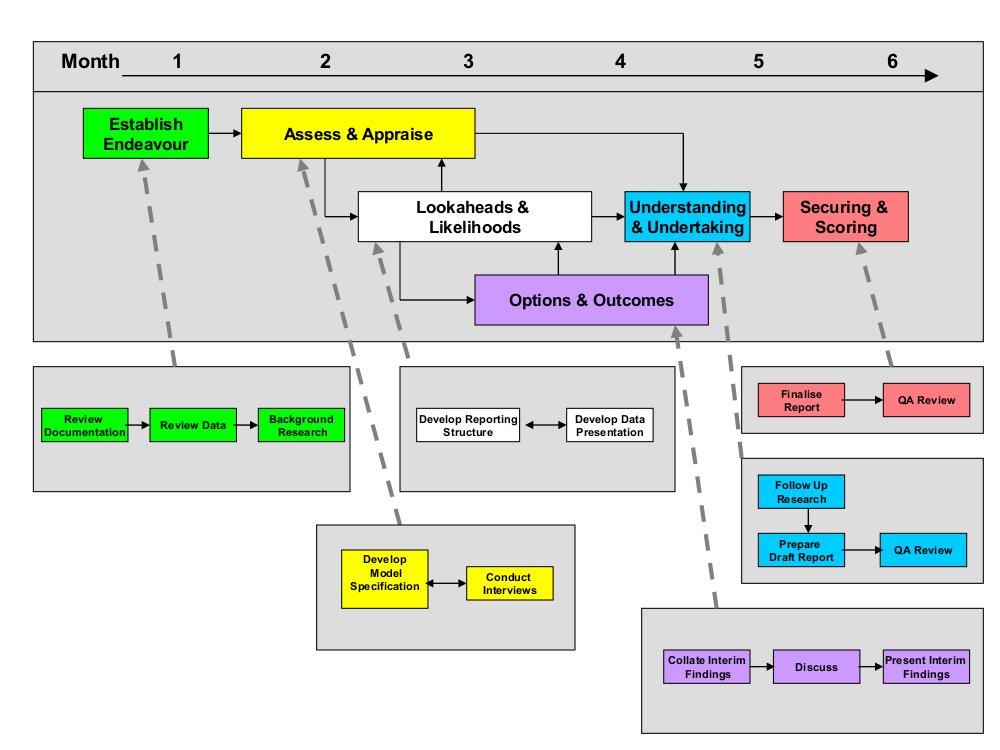Z/EALOUS
Z/Yen deploys risk/reward management using its proprietary Z/EALOUS methodology. Z/EALOUS is a six-stage, general problem-solving tool that Z/Yen people use to help clients make better decisions. Z/EALOUS consists of a strategic framework, supporting software, procedures, case studies and report formats that have successfully improved client strategies, marketing, finance, information technology, human resources and cost-effectiveness. Z/EALOUS has been qualitatively and quantitatively assessed on several hundred assignments since 1994. Z/EALOUS has led to Z/Yen and Z/Yen clients’ outstanding performance on improving organisations.
The origins of risk/reward philosophy lie in risk management, an approach which surfaces in fields as diverse as banking, health, insurance, engineering and project management. The techniques used in risk management are similar from field to field - risks are the probability of an adverse occurrence; risks can be measured by severity and likelihood; risks can be accepted, avoided, mitigated or transferred. Risk management as a discipline has assembled a set of powerful tools culled from a variety of disciplines - actuarial tools, engineering tools and simulation tools.
Today’s risk is tomorrow’s reward; tomorrow’s reward is today’s risk. Risk/reward philosophy recognises the duality. A potentially world-beating new product (full of rewards) is also a potential flop (risks). A potentially weak distribution network (risk) may hasten moving to the internet (reward). Risk/reward philosophy provides a meta-viewpoint and meta-methodology for successfully solving organisational problems at all levels, from the strategic to the mundane, within an integrated framework. Systems thinking, hard and soft, underpins risk/reward philosophy.
Z/EALOUS Risk/Reward Methodology

Z/EALOUS’ six stages are:
- Establish Endeavour – ensure we understand the problem(s) and stakeholders;
- Assess & Appraise – gather knowledge on severity and benefit of impacts;
- Lookaheads & Likelihoods – evaluate scenarios and frequency of occurrence;
- Options & Outcomes – structure responses for a decision;
- Understanding & Undertaking – plan the solution;
- Securing & Scoring – manage the solution and evaluate the final outcome.
Z/EALOUS is applied to a variety of projects. A six-week, sample work programme might look like the following:

The Z/EALOUS questionnaires were all designed with a major theme and an associated colour from De Bono’s Six Thinking Hats. The structure of the phases is:
| Phase | Colour | Theme Underlying Most Questions |
|---|---|---|
| Establish Endeavour | Green | largely Critical System Heuristics (CSH) “is” [Ulrich, 1983] |
| Assess & Appraise | Yellow | framework for tools for issue generation and appraisal [various strategic authors and tools – for overview see HUSSEY, D. E., “Glossary of Techniques for Strategic Analysis”, Journal of Strategic Change, Vol. 6, April 1997, pp. 97-115] |
| Lookaheads & Likelihoods | White | risk/reward philosophy [internally generated] |
| Options & Outcomes | Blue | largely CSH “ought” [Ulrich, 1983] |
| Understanding & Undertaking | Purple (De Bono’s black) | project definition strongly influenced by Chapman and Ward [1997] |
| Securing & Scoring | Red | obtaining results and evaluating the problem-solving [internally generated] |
Supporting software includes word processing and diagram templates, but also PropheZy, Z/Yen’s risk/reward prediction engine.
| Establish Endeavour | Assess & Appraise | Lookaheads & Likelihoods | Options & Outcomes | Understanding & Undertaking | Securing & Scoring |
|---|---|---|---|---|---|
| mission | issues | probabilities | decisions | projects | behaviour |
| beliefs | possibilities | choices | plans | culture | desires |
| potential | ideas | scenarios | policies | programme | habits |
| means | stories | heuristics | feasibility | organisation | norms |
| aims | viewpoints | assessment | frameworks | targets | resources |
| values | investigation | priorities | estimates | actions | success |

Four of the six Z/EALOUS phases are analytical, but two are very much about implementing and evaluating – “Understanding & Undertaking”, “Securing & Scoring”. Risks and rewards need both feed-back control and feed-forward control (anticipation). Systems, and sub-systems, need to be constructed in order to develop, implement and control risk/reward beliefs:
- culture - risk/reward philosophy develops empowering, performance-enhancing information, process and reward systems aligned with the organisation’s risk/reward, the organisation’s people and their beliefs;
- integration - risk/reward philosophy integrates active and passive; emergent and directive; strategy and tactics. Risk/reward works with imperfect information and directs quantitative work to the areas of highest potential return, not just the most easily available numbers. The organisation develops a commonly used set of techniques, building the stock of decision-making knowledge and unifying organisational analytical effort;
- dynamism - the focus on decision-making, as well as the ability to cascade risk/reward sets both up and down the organisation, permits decisions to be made separately in different parts of the organisation while increasing the likelihood that separate decisions are complementary;
- robustness - changes in risk/reward perceptions through new information or new ways of analysing the environment invigorate the strategy rather than destroy a fragile intellectual edifice. The strategy needs to be reviewed when risks or rewards change, not just on an artificial calendar cycle.
Risk/reward philosophy helps decision makers reduce the risk of failure while enhancing their rewards - risk/reward ‘enchancement’.
References
- ULRICH, Werner: Critical Heuristics of Social Planning (John Wiley & Sons Ltd, 1983).
- DE BONO, Edward: Six Thinking Hats (Penguin Books, 1985).
- CHAPMAN, Chris and Stephen Ward: Project Risk Management (John Wiley & Sons Ltd, 1997).